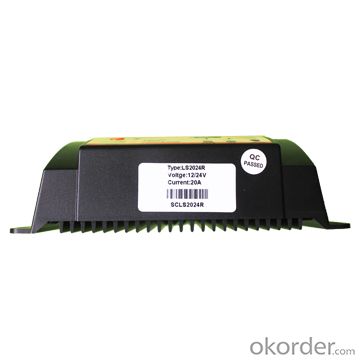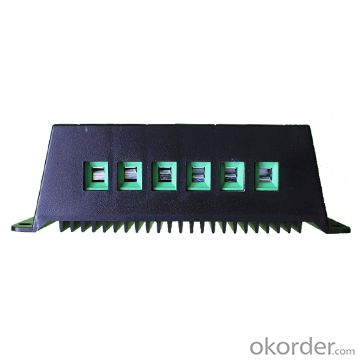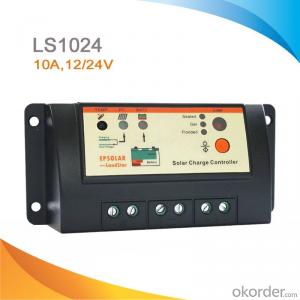PWM Solar Charge Controller with Power Switch for Solar Home System,10A ,12/24V LS1024
OKorder Service Pledge
OKorder Financial Service
You Might Also Like
Solar Charge Controller Descriptions:
LandStar series solar charge controller is a new generation lighting controller for off-grid solar system, such as home system, traffic system, CCTV system. It adopts the most advanced digital technique and operates fully automatically.

Features:
12V/24V automatic identify or user-defined working voltage.
With functions of current power calculation, it is convenient to view charging and discharging energy of each day, month, year and total value.
Wide input voltage range: DC8.0V---DC32V, compatible with 12V/24/ full voltage range.
Digital precision constant current control and the control accuracy are better than 2%
Maximum output efficiency of 95%
The rated output current can be adjusted at rated power and current range.
The max current output voltage can reach up to 60V
Charge control parameter, the load control parameter and the output current value can be set separately
Use standard Modbus communication protocol for TTL232 bus connection, communication protocol compatibility much better.
Fully encapsulated PCB, IP67 protection
Aluminum housing
Electronic Protections:
·Overheating
·Over discharging
·Over charging
·Load overload
·Load short circuit
·PV short circuit
·PV reverse polarity
·Battery reverse polarity
Specification:
Electrical parameters | LS1024 | LS2024 |
Nominal System Voltage | 12 / 24VDC auto work | |
Rated Battery Current | 10A | 20A |
Max. Battery Voltage | 32V | |
Charge Circuit Voltage Drop | ≤0.26V | |
Discharge Circuit Voltage Drop | ≤0.15V | |
Self-consumption | ≤6mA | |
Overall dimension | 140 x 65 x 34mm | 144 x 75x 45mm |
Terminal | 4mm2 | 10mm2 |
Net weight | 0.15kg | 0.25kg |
Working temperature | -35℃ to +55℃ | |
Humidity | 10%-90% NC | |
Enclosure | IP30 | |
Battery Voltage Parameters (temperature at 25℃) | |||
Battery charging setting | Gel | Sealed | Flooded |
Equalize Charging Voltage | —— | 14.6V;x2/24V | 14.8V;x2/24V |
Boost Charging Voltage | 14.2V;x2/24V | 14.4V;x2/24V | 14.6V;x2/24V |
Float Charging Voltage | 13.8V;x2/24V | 13.8V;x2/24V | 13.8V;x2/24V |
Low Voltage Reconnect Voltage | 12.6V;x2/24V | 12.6V;x2/24V | 12.6V;x2/24V |
Low Voltage Disconnect Voltage | 11.1V;x2/24V | 11.1V;x2/24V | 11.1V;x2/24V |
Equalize Duration | —— | 2 hours | 2 hours |
Boost Duration | 2 hours | 2 hours | 2 hours |


- Q:Can a solar controller be used with solar-powered irrigation systems?
- Yes, a solar controller can be used with solar-powered irrigation systems. A solar controller helps regulate the power output from solar panels and ensures optimal charging of batteries, which are typically used to store energy for irrigation systems. By using a solar controller, the system can efficiently utilize solar energy to operate the irrigation system.
- Q:How do I ensure compliance with local regulations when installing a solar controller?
- To ensure compliance with local regulations when installing a solar controller, it is important to familiarize yourself with the specific regulations in your area. This can be done by researching local codes, permits, and requirements related to solar installations. It is advisable to consult with local authorities or regulatory bodies to ensure that you are meeting all the necessary guidelines. Additionally, hiring a licensed and certified professional for the installation can help ensure compliance with local regulations and standards.
- Q:Can a solar controller be used with solar panels of different temperatures?
- Yes, a solar controller can be used with solar panels of different temperatures. The purpose of a solar controller is to regulate the charging and discharging of batteries connected to the solar panels. It ensures that the batteries receive the optimum amount of charge regardless of the temperature of the solar panels.
- Q:What is the temperature compensation range of a solar controller?
- The temperature compensation range of a solar controller typically varies between -10°C to +40°C.
- Q:How does a solar controller handle battery overvoltage disconnect recovery?
- The battery overvoltage disconnect recovery is managed by a solar controller, which utilizes specific functions and features. When the battery voltage surpasses a particular threshold, the overvoltage disconnect feature of the controller is activated. This feature separates the charging source (solar panel) from the battery to prevent further charging. Once the overvoltage disconnect is triggered, the solar controller enters a recovery mode. Throughout this period, the controller continuously monitors the battery voltage to guarantee that it decreases below a safe level before reconnecting the charging source. This is crucial for safeguarding the battery against potential damage caused by excessive voltage. The recovery process typically includes gradually reconnecting the charging source to the battery. The controller may employ a mechanism that delays reconnection, allowing the battery voltage to stabilize and decrease to a safe level before resuming the charging process. This helps prevent any sudden increases in voltage that could harm the battery. Furthermore, some solar controllers may incorporate a soft-start feature during the recovery phase. This means that instead of immediately supplying the battery with the full charging current, the controller begins with a lower current and gradually increases it until it reaches the desired charging rate. This gentle approach prevents any sudden shocks to the battery resulting from a sudden surge in charging current. In conclusion, the battery overvoltage disconnect recovery mechanism of a solar controller ensures the safe and efficient charging of the battery by carefully monitoring its voltage and implementing gradual reconnection strategies to prevent any further instances of overvoltage.
- Q:How does a solar controller prevent damage to the solar panels from overvoltage conditions?
- The flow of electricity from the solar panels to the battery or grid is regulated by a solar controller to prevent damage to the panels caused by overvoltage conditions. Acting as a bridge between the panels and the battery or grid, it guarantees that the voltage output from the panels remains within safe limits. When generating electricity, the solar panels produce a voltage that varies depending on the intensity of sunlight. However, this voltage can fluctuate due to factors like weather conditions and panel temperature. Exceeding the safe operating range can result in panel damage. Constantly monitoring the voltage output from the panels, the solar controller activates a mechanism to prevent excess voltage from reaching the panels if it detects that the voltage is too high. Depending on the type of solar controller, this mechanism can involve techniques such as pulse width modulation (PWM) or maximum power point tracking (MPPT). PWM controllers regulate the voltage by rapidly switching the connection between the panels and the battery on and off. This effectively reduces the average voltage reaching the panels, preventing overvoltage conditions. On the other hand, MPPT controllers optimize energy conversion by adjusting the electrical load to extract maximum power from the panels without exceeding the safe voltage threshold. In both cases, the solar controller ensures that the voltage output from the panels remains within the specified range, safeguarding them from potential damage. Advanced solar controllers may also incorporate features such as temperature compensation to account for temperature variations, further enhancing the protection of the panels. In conclusion, a solar controller safeguards the solar panels from damage caused by overvoltage conditions by regulating and controlling the voltage output from the panels. Techniques like PWM or MPPT are employed to keep the voltage within safe limits. This protection mechanism prolongs the lifespan and enhances the efficiency of the panels, maximizing their performance and return on investment.
- Q:How do I calculate the required solar panel capacity for a solar controller?
- To calculate the required solar panel capacity for a solar controller, you need to consider several factors: 1. Determine your energy needs: Firstly, you need to determine the amount of energy you require to power your devices or appliances. This can be done by calculating the total wattage of all the devices you wish to run on solar power. 2. Estimate daily energy consumption: Next, estimate your daily energy consumption by multiplying the wattage of each device by the number of hours you expect to use it. Add up these values to get your total daily energy consumption in watt-hours (Wh). 3. Account for efficiency and losses: Solar panels do not convert 100% of the sunlight they receive into usable electricity. To account for efficiency and losses, multiply your total daily energy consumption (in Wh) by a factor of 1.25 to 1.5, depending on the efficiency of your solar panels and system. 4. Account for location and climate: The amount of sunlight available varies depending on your location and climate. Consider the average daily sunlight hours in your area to estimate the daily energy production of your solar panels. Multiply your adjusted daily energy consumption (from step 3) by 1.25 to 1.5 to account for the location and climate factors. 5. Calculate panel capacity: Finally, divide the adjusted daily energy consumption (from step 4) by the average daily energy production of a solar panel. This will give you the required solar panel capacity in watts (W) or kilowatts (kW). It's important to note that this calculation provides an estimate and it's recommended to consult with a solar professional or use online solar calculators for more accurate results. Additionally, consider factors like future energy needs, system expansion, and storage capacity if you plan to incorporate battery systems.
- Q:What is the maximum number of user profiles supported by a solar controller?
- The maximum number of user profiles supported by a solar controller can vary depending on the specific model and brand. However, in general, solar controllers typically support multiple user profiles, ranging from as few as 2 to as many as 10 or more.
- Q:How do I calculate the required charging current for a solar controller?
- To calculate the required charging current for a solar controller, you need to consider the battery capacity and the desired charging time. Divide the battery capacity (in ampere-hours) by the desired charging time (in hours) to determine the required charging current (in amperes).
- Q:What is the maximum load capacity that a solar controller can handle?
- The maximum load capacity that a solar controller can handle depends on its make and model. The load capacity is typically specified by the manufacturer and can vary greatly. It is important to consult the product specifications or contact the manufacturer for accurate information regarding the maximum load capacity of a specific solar controller.
1. Manufacturer Overview |
|
|---|---|
| Location | |
| Year Established | |
| Annual Output Value | |
| Main Markets | |
| Company Certifications | |
2. Manufacturer Certificates |
|
|---|---|
| a) Certification Name | |
| Range | |
| Reference | |
| Validity Period | |
3. Manufacturer Capability |
|
|---|---|
| a)Trade Capacity | |
| Nearest Port | |
| Export Percentage | |
| No.of Employees in Trade Department | |
| Language Spoken: | |
| b)Factory Information | |
| Factory Size: | |
| No. of Production Lines | |
| Contract Manufacturing | |
| Product Price Range | |
Send your message to us
PWM Solar Charge Controller with Power Switch for Solar Home System,10A ,12/24V LS1024
OKorder Service Pledge
OKorder Financial Service
Similar products
New products
Hot products
Hot Searches
Related keywords































